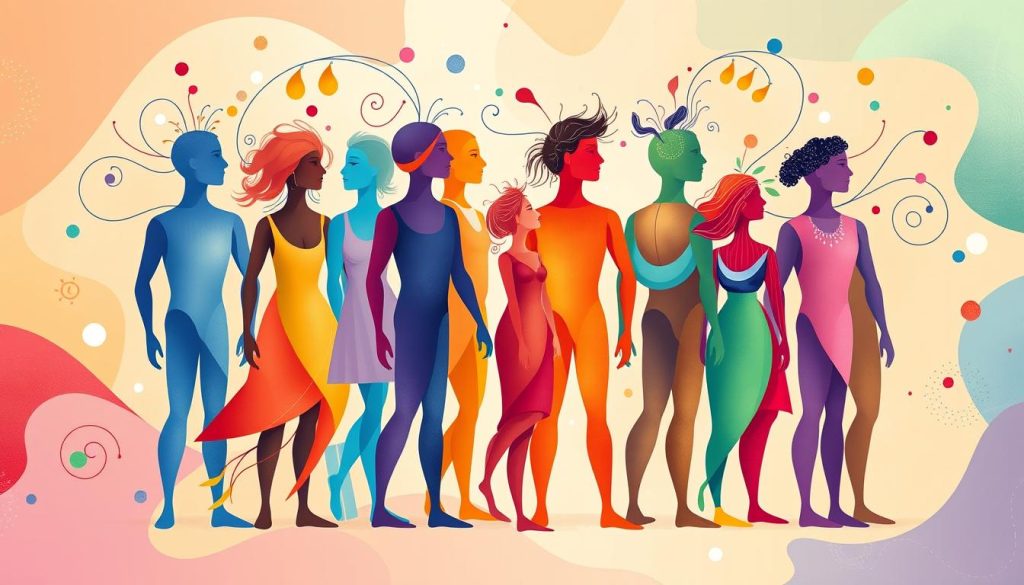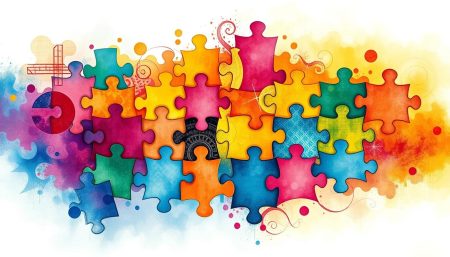Today, we focus on challenging internalized ableism in those with Autism Spectrum Disorder (ASD). The path to autism empowerment is filled with societal pressures and personal struggles. These are all part of the quest for self-acceptance and autism.
This issue often shows up as a negative view of one’s neurodivergence. It’s shaped by the negative views of others.
This part talks about the quiet battle autistics face in a world that often doesn’t get them. The journey to true self-acceptance is both personal and collective. It’s about breaking down old, harmful views.
As we dive into this, we highlight the value and talent in every autistic person. This shows a shift towards real inclusion in society.
Understanding Autism Spectrum Disorder
Autism Spectrum Disorder (ASD) is a range of conditions. It affects social behavior, communication, and language. It also involves a narrow range of interests and activities that are unique and repetitive. Learning about the basics of autism and moving beyond old views is key to accepting neurodiversity.
The Basics of ASD
ASD is a developmental disorder that starts in early childhood and lasts a lifetime. Understanding the basics of autism means seeing how it varies. Some people need a lot of support, while others live independently.
Redefining Autism: Beyond the Stereotypes
We need to break free from old autism stereotypes that focus on what’s lacking. Redefining autism means seeing the unique abilities and views of autistic people. This shift helps us value their contributions and promotes neurodiversity acceptance.
This change is making our understanding of autism more inclusive and empowering. It benefits not just those on the spectrum but society as a whole.
| Aspect | Common Misconception | Current Understanding |
|---|---|---|
| Social Interaction | Autistic individuals prefer being alone. | Many autistic individuals are social but may interact in different ways. |
| Communication | Limited or no verbal communication abilities. | Communication varies widely; some are non-verbal but use assistive technologies to communicate. |
| Interests | Only interested in “narrow” activities. | Interests may be intense but can be broad and highly sophisticated. |
Defining Internalized Ableism and Its Roots
Internalized ableism is a form of discrimination that affects people with disabilities. It makes them doubt themselves. This happens because society often sees disabilities as bad or unwanted.
Internalized ableism happens when people with disabilities start to believe these negative views. It’s important to fight this to help people accept themselves. This fight is key to making society see neurodiversity in a positive light.
- The roots of internalized ableism come from how media shows disabilities, the way education values them less, and the lack of positive disabled role models.
- Changing how society sees neurodiversity means empowering people to reject negative views about themselves.
We need to focus on overcoming internalized ableism. This means changing how we see and value disabilities. It’s important for creating a place where neurodiverse people can grow and succeed without being held back by stigma.
Getting rid of internalized ableism is key to ending stigma against neurodiversity. It stops people from growing and keeps society divided. So, understanding and fighting internalized ableism is vital for a society that values neurodiversity.
Autism Spectrum Disorder Internalized Ableism
It’s important to see how society’s prejudices affect people with autism. They often feel they’re not good enough or can’t do things. This makes them feel bad about themselves and not want to try new things.
Embracing neurodiversity is key to fighting these feelings. By seeing neurodiversity as a natural part of us, we can make a place where autistic people feel valued. This change helps remove obstacles and promotes acceptance.
- Highlighting the strengths and unique talents of individuals on the autism spectrum.
- Providing supportive communities that affirm the identities of autistic individuals.
- Promoting inclusive practices in education and employment that accommodate diverse neurological conditions.
By tackling internalized ableism in autism, we can help people with autism break free from ableism. It’s about both personal efforts and big changes in how we see and support neurodiversity. When we celebrate all kinds of diversity, everyone can thrive in society.
Neurodiversity Acceptance and Its Importance
Neurodiversity acceptance is more than a trend; it’s a big change in how we see autism spectrum disorders. It’s about valuing the strengths of autistic individuals and not just their challenges. This shift helps make our world more inclusive.
Moving Towards Neurodiversity
Adopting neurodiversity means seeing autism as a natural part of human variation. This view is key to creating spaces where promoting autism self-advocacy is essential. It lets autistic people lead in talking about their needs and dreams.
Recognizing the Strengths of Autistic Individuals
Seeing the many talents in the autism community challenges old views and adds richness to our lives. By celebrating the strengths of autistic individuals, we open doors to new ideas, creativity, and contributions in many areas.

| Strength | Examples of Contributions |
|---|---|
| Attention to Detail | Enhanced abilities in coding, accounting, and art. |
| Persistent Focus | Long-term project management in scientific research and development. |
| Systematic Thinking | Advances in logic-based fields such as mathematics and engineering. |
| Creative Problem Solving | Unique approaches in design, music composition, and creative writing. |
By supporting autism self-advocacy and neurodiversity acceptance, we help autistic people and make our society better. This positive approach reduces stigma and fully includes autistic individuals in our communities.
Identifying Signs of Internalized Ableism in Autism
Internalized ableism is a big challenge for people with autism. It means accepting negative views about their disabilities. Recognizing ableism in oneself is key to self-acceptance and raising autism awareness. Let’s explore how it shows up.
- Self-deprecating Thoughts: These are beliefs that one’s abilities are less than those of others.
- Reluctance in Self-Advocacy: Not wanting to speak up for one’s rights or needs, feeling they’re not deserved.
- Over-internalizing Failures: Blaming oneself too much for failures, seeing them as due to autism, not circumstances.
- Minimizing Successes: Believing successes are luck or help from others, not one’s own efforts.
Seeing these signs of internalized ableism is the first step to overcoming them. It’s about moving towards self-acceptance and empowerment. Recognizing ableism frees individuals from self-doubt and helps change society towards acceptance and inclusion.
Overcoming Internalized Ableism: Strategies for Change
It’s key to tackle internalized ableism to empower autism. By using specific strategies, people can build a better self-image and support others on the spectrum.
Embracing Self-Acceptance and Autism
Self-acceptance is a big step against internalized ableism. It means seeing and valuing the unique strengths of being autistic. This acceptance helps fight off negative views from society.
Employing Tools for Positive Self-Image
Having a positive self-image is essential for autism. There are tools and practices that help boost self-worth. Here are some practical ways to support this journey:
- Regular participation in workshops centered on autism empowerment
- Engagement with positive role models within the autistic community
- Use of affirmations tailored to reinforce self-acceptance
These tools help grow personally and push for a wider acceptance of neurodiversity.
| Tool | Description | Impact |
|---|---|---|
| Workshops | Interactive sessions that focus on strengths and capabilities | Increases confidence and community bonding |
| Role Models | Exposure to successful individuals on the spectrum | Inspires and motivates personal and professional growth |
| Affirmations | Positive, empowering statements to boost self-esteem | Reinforces a healthy, positive mindset daily |
Autism Empowerment: Celebrating Achievements and Unique Talents
Highlighting the successes and unique abilities of autistic individuals is key to autism empowerment. This helps uplift the spirits in the autism community. It’s about the impact of autistic role models and the role of autism community support.
Autistic Role Models and Success Stories
Autistic role models have made a big impact in various fields. They show that autism is not a barrier to greatness. Their achievements help change how people see autism and encourage young autistic individuals.
Fostering a Sense of Community and Support
Autism community support is vital for creating safe spaces. It makes individuals feel valued and recognized for their unique contributions. This support comes in many ways, like mentoring, workshops, and online communities.
- Development of mentorship programs that connect newly diagnosed individuals with seasoned autistic leaders.
- Organizing workshops that focus on areas such as self-advocacy, talent development, and adaptive life skills.
- Expansion of online platforms that provide resources and forums for autistic individuals worldwide to connect and share their experiences.
These efforts help make autism empowerment a part of daily life and interactions in the community.
| Initiative | Description | Impact on Community |
|---|---|---|
| Mentorship Programs | Personalized guidance from experienced individuals within the autism community. | Builds confidence and shares practical advice for navigating daily challenges. |
| Educational Workshops | Sessions tailored to enhance particular skills and provide learning opportunities. | Empowers participants by improving life skills and broadening perspectives. |
| Online Resource Platforms | Accessible tools and forums designed to connect and educate. | Creates a global network of support and knowledge exchange. |
Challenging Ableist Beliefs: From Society to Self
To fight against ableist beliefs and destigmatize neurodiversity, we must tackle prejudices in society and in ourselves. The first step is to understand and acknowledge these biases.
Changing ableist beliefs starts with educating the public. It then moves to personal reflection and change. Awareness helps build a base where neurodiversity stigmas start to fade away.
- Public initiatives that showcase the abilities and achievements of those on the autism spectrum.
- Workshops and seminars that focus on destigmatizing neurodiversity at community centers, schools, and workplaces.
- Social media campaigns that highlight personal stories of individuals overcoming internalized ableism.
Personal reflection is key in challenging ableist beliefs. People on the autism spectrum can find self-acceptance by exploring their own stories. These stories show the diversity within the autism community.
Our journey to destigmatize neurodiversity is about more than changing how others see us. It’s about empowering us to see ourselves in a new light, free from self-doubt.
Breaking Free From Ableism: Personal Journeys and Narratives
In today’s world, where diversity is celebrated, stories of autism offer deep insights. These stories show the strength and unique views of those on the autism spectrum. They help us understand and accept autism better, thanks to the support of allies.
Sharing Experiences to Empower Others
Sharing personal stories can spark change. By sharing their autism journeys, individuals take back their stories. They also light the way for others, building a sense of community and empowerment.
These stories connect with many people, breaking down barriers. They create a space where autistic voices are valued and heard. By sharing their experiences, people help fight stigma and promote inclusion.
The Role of Allies in Amplifying Autistic Voices
Allies are key in making autistic voices heard. They include educators, family, professionals, and friends. Allies help autistic voices reach more people, sharing their unique views.
- Supporting authentic representations in media and public engagements
- Advocating for inclusive policies and practices in educational and professional settings
- Encouraging and facilitating inclusive dialogues that respect and highlight autistic perspectives
Allies create spaces where autistic voices lead. They help shape stories that reflect autistic experiences, not just about them but by them.
| Impact Areas | Benefits |
|---|---|
| Media Representation | Enhances public understanding and acceptance |
| Educational Policies | Produces environments that foster success for autistic students |
| Professional Inclusion | Increases job opportunities and fair treatments in the workplace |
The mix of personal stories and ally support makes our society better. Together, they help us overcome ableism’s barriers. This way, we can create a more welcoming and diverse world.
Promoting Autism Self-Advocacy and Agency
Working to understand and empower those on the autism spectrum is key. Promoting autism agency is a big part of this. It helps break down barriers, making the world more welcoming and supportive.
The Power of Self-Advocacy Groups
Self-advocacy groups are very important. They give people a voice to share their experiences and needs. This helps change society and make things better for everyone.
These groups empower people to speak up. They help create a world where voices are heard and matter. This is important for shaping policies and practices.
Tools and Resources for Autism Advocacy
Having the right resources is vital for autism advocacy. These tools are more than just help—they are essential for everyday life. They offer guidance, support, and information to face challenges and advocate for oneself.
| Resource Type | Description | Impact |
|---|---|---|
| Educational Workshops | Programs designed to teach advocacy skills and legal rights | Increases confidence and knowledge |
| Online Platforms | Websites and forums dedicated to sharing strategies and personal stories | Facilitates community and peer support |
| Legal Assistance | Access to legal advice for discrimination and rights protection | Empowers individuals to seek justice and equal treatment |
Destigmatizing Neurodiversity in the Media and Public Perception
The journey to destigmatizing neurodiversity is greatly helped by how the media represents autism. This affects how the public sees autism. When media shows autism accurately, it helps break down harmful stereotypes. It also encourages more people to understand and accept neurodiverse individuals.
To see how we’re doing, we need to look at how media shows autism. Here’s a table that shows how different media types portray autism.
| Media Type | Portrayal Quality | Frequency of Representation | Impact on Public Perception |
|---|---|---|---|
| Television | Mostly Positive | High | Significantly Positive |
| Films | Mixed | Moderate | Moderately Positive |
| Online Media | Varied | High | Highly Influential |
| Print Media | Generally Positive | Low | Low Impact |
Television and online media have the biggest impact on how we see autism. This shows why it’s key to push for accurate media representation of autism. These platforms reach many people and can either keep stereotypes alive or help us understand and accept each other better.
Improving how neurodiverse people are shown in media is key to destigmatizing neurodiversity. It helps make society more welcoming. This effort not only helps those on the autism spectrum but also makes our communities richer by celebrating diversity.
Embracing Neurodiversity in Education and the Workplace
In today’s world, embracing neurodiversity is key in education and work. We need to create places that support all kinds of brains. This helps everyone reach their full ability.
Inclusive Education Strategies
Schools are changing to help neurodiverse students. They use new teaching methods and make learning spaces better. This makes education fairer and more fun for everyone.
- Teachers use visuals, tech, and hands-on activities to help students learn.
- They make special plans for each student with autism to help them learn better.
- Teachers learn about neurodiversity to create supportive learning spaces.
Autism-Friendly Workplace Practices
Making a workplace friendly for autism is more than following laws. It’s about creating a welcoming place. Companies that support neurodiversity see better ideas, happier employees, and a wider range of talent.
- Workplaces with clear rules and routines help people with autism.
- Companies look for and train neurodiverse employees to join their teams.
- They offer quiet areas for breaks to help reduce stress.
The graphic below shows how schools and businesses support neurodiversity.

| Area | Inclusive Education Practices | Autism-Friendly Workplace Practices |
|---|---|---|
| Tools and Adaptations | Interactive tech, visual aids, personalized curriculums | Structured tasks, clear guidelines, sensory-friendly spaces |
| Staff Training | Regular workshops on neurodiversity and inclusive methods | Autism awareness training and support strategies |
| Policy Development | Development of IEPs for neurodiverse students | Recruitment policies inclusive of neurodiverse individuals |
This way of supporting neurodiversity can change education and work. It leads to a more inclusive society.
Legal Protections and Rights for Individuals with Autism
Ensuring legal protections for autism is key to giving those on the spectrum equal chances and rights. In the U.S., laws like the Americans with Disabilities Act (ADA), the Individuals with Disabilities Education Act (IDEA), and the Rehabilitation Act help. These laws fight against discrimination and ensure equal access to education, jobs, and public places.
People with autism face big challenges, like dealing with social norms and myths. It’s important for them, their families, and supporters to know about these laws. Knowing about these laws helps them get the help they need and fight for their rights.
To learn more about autism and how it’s different from mental health issues, there’s plenty of info out there. This info helps clarify the differences and shows the need for specific support and therapy.
Even with strong federal laws, the fight for equality and acceptance goes on. Groups dedicated to autism advocacy work hard to improve laws and meet the community’s changing needs. This effort leads to a more inclusive society, where people with autism can make great contributions.
FAQ
Q: What is Internalized Ableism in the Context of Autism Spectrum Disorder?
A: Internalized ableism is when people with autism accept negative views about disabilities. This can lower their self-esteem and make it hard to accept themselves.
Q: How Can People with Autism Combat Internalized Ableism?
A: To fight internalized ableism, people with autism can learn about neurodiversity. They can also connect with others who have autism, find positive role models, and speak up for themselves. It’s important to challenge negative thoughts about oneself.
Q: What Are Some Common Misconceptions About Autism?
A: Many people think autistic individuals lack emotions or empathy. They believe all autistics are the same and that autism needs to be “cured.” But, neurodiversity acceptance celebrates the natural differences in people.
Q: Why Is Neurodiversity Acceptance Important?
A: Accepting neurodiversity is key because it values brain differences. It helps create inclusive spaces where everyone feels valued and has equal chances.
Q: What Are Some Signs of Internalized Ableism in Individuals with Autism?
A: Signs include feeling ashamed of being autistic, not asking for help, or downplaying struggles. Using ableist language about oneself or others is also a sign.
Q: How Can Autistic Individuals Embrace Self-Acceptance?
A: To accept oneself, autistic individuals should focus on their strengths. They should set boundaries, take care of themselves, and celebrate their autism. Connecting with the autism community helps too.
Q: How Can We Challenge Societal Ableist Beliefs?
A: We can challenge ableism through education and awareness. Sharing stories of autistic success and pushing for change helps. It’s about valuing everyone, no matter their neurotype.
Q: What Role Do Allies Play in Supporting Autistic Individuals?
A: Allies are vital by listening to and amplifying autistic voices. They challenge harmful narratives, support autism-friendly policies, and advocate with the autism community.
Q: How Can Autistic Individuals Get Involved in Self-Advocacy?
A: Autistic individuals can join advocacy groups, learn about their rights, and find mentors. Using social media to share experiences and promote advocacy is also effective.
Q: Why Is Accurate Media Representation of Autism Important?
A: Accurate media helps fight stereotypes and misinformation. It fosters inclusivity and helps people understand and accept autism better.
Q: What Are Some Strategies for Enabling Neurodiversity in Education and the Workplace?
A: Strategies include tailored education and training on neurodiversity. Providing accommodations and valuing diverse thinking styles are also key.
Q: What Legal Protections Exist for Individuals with Autism?
A: Legal protections vary but often include anti-discrimination laws and rights to accommodations. The Americans with Disabilities Act (ADA) is a key example.


















